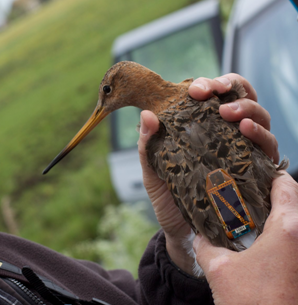New GPS mini-tracker facilitates investigation into movement of smaller animals
Wednesday, July 4th, 2012
In response to the needs of researchers studying smaller animals, a new GPS mini-tracker weighing 5.8 grams has been developed. Like the older tracker, the new device is capable of measuring GPS location, acceleration and internal temperature of the device, but now within a smaller and lighter package.
The accelerometer has been redesigned with an adjustable sample rate enabling higher resolution acceleration sampling (20 or 50 samples per second). The ability to collect 50 samples per second is vital when studying smaller species with faster movements, like birds with high wing beat frequencies.
The weight of the device is partly determined by several optional features, such as the addition of strap eyes necessary for using a harness to mount the logger to the animal. The mini-tracker can be glued to the animal thereby eliminating the 0.5-gram strap eyes. Weight increases slightly if an internal chip antenna is selected instead of a flexible external antenna.
Battery choice also influences weight; the user can choose between 10 mAh, 30 mAh or 65 mAh batteries, depending on their research needs. A larger battery is essential for collecting measurements in low-light situations such as during cloudy weather, winter in northern latitudes and nighttime. In contrast, choosing the 10 mAh battery and excluding the strap eyes can result in a device weighing as little as 5.8 grams. The “heaviest” tracker weighs about 7.5 grams. The batteries are charged by two independently controlled solar cells.
The memory of the device is eight times larger than the original GPS loggers (now 32 MB) allowing for the storage of approximately 320,000 fixes before downloading data becomes necessary.
In addition, a three-axis earth magnetic compass sensor is under development which will allow data to be collected on the compass direction and vertical/horizontal orientation of the animal, useful for determining the body angle of birds flying in a crosswind. The device’s design also permits the placement of additional sensors for measuring air humidity and pressure, at the user’s request.
Currently four prototype trackers are flying around. Two trackers were placed on Black-tailed Godwits that were tagged in Friesland (NL) and recently left for Africa. Two other trackers were used on Caspian Terns, tagged in Fagelsundet (a small island west of Sweden). Some more prototypes will be used on Eleanora’s Falcons and on Honey Buzzards later this year. We expect that the trackers will be available for other projects by the end of 2012.
Latest Highlights

Overwintering and foraging areas used by a 24-year old Eurasian spoonbill
Wednesday, April 18th, 2018

Lesser Black-backed Gulls from Schiermonnikoog enjoy their winter holiday
Tuesday, April 3rd, 2018

Oystercatchers returning from inland breeding grounds
Sunday, July 23rd, 2017

GPS tracker with SMS messaging
Monday, November 2nd, 2015

Ronny found back, three years after deployment of the UvA-BiTS GPS-tracker
Wednesday, July 8th, 2015

Lesser Black-backed Gulls feed on potato crisps in Moeskroen
Wednesday, November 13th, 2013

‘Vogel het uit!’ has won the 2013 Academic Year Prize
Tuesday, November 5th, 2013

Back in Europe: UvA-BiTS Honey Buzzard photographed at the Strait of Gibraltar
Wednesday, May 15th, 2013

UvA-BiTS database passes 10 million record mark
Wednesday, May 8th, 2013

Gulls pouring into the Kelderhuispolder colony
Wednesday, April 17th, 2013

To the Karoo and back: Mate replacement & GPS tracking study of an ousted eagle
Monday, March 25th, 2013

Meeting Montagu’s Harrier Edwin in Senegal
Wednesday, March 20th, 2013

Oystercatchers: Learning how and where to survive
Wednesday, August 29th, 2012

New GPS mini-tracker facilitates investigation into movement of smaller animals
Wednesday, July 4th, 2012

Over 5 million GPS fixes in the UvA-BiTS database
Thursday, June 21st, 2012

Tagged Lesser Black-backed Gulls return to Orford Ness
Wednesday, April 18th, 2012

Gulls spotted in their over-wintering areas
Wednesday, December 21st, 2011

The UK a top vacation destination in 2011
Wednesday, July 13th, 2011

A long way from home
Sunday, June 26th, 2011

Visiting Amsterdam for a day
Saturday, May 14th, 2011

Female deserts brood, male raises chicks
Friday, May 13th, 2011

Wintering range in Sierra Leone
Friday, May 13th, 2011

Camera watches foraging Oystercatchers day and night
Thursday, May 12th, 2011

The return of a bird presumed dead
Wednesday, May 11th, 2011

Texel gulls back from wintering areas
Sunday, May 1st, 2011

First Lesser Black-backed Gull returns to the breeding colony
Monday, April 13th, 2009



